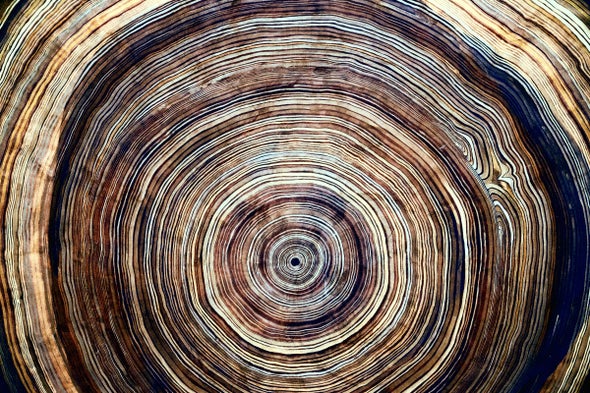(单词翻译:单击)
听力文本
This is Scientific American's 60-second Science, I'm Christopher Intagliata.
Rome wasn't built in a day. And neither was the Roman subway system. Underground work is slow going, because construction crews often unearth mosaics, frescos, marble. And a few years ago, they found the wooden foundations of a luxurious porch from a Roman villa.
So local archaeologists called in Mauro Bernabei of the National Research Council of Italy. He's a dendrochronologist: someone who analyzes tree rings, which give age and environmental info.
"We have to study wood because it's full, really full, of information!"
Bernabei and his team found that the wooden planks were oak. But the wood's origin was harder to determine. So they compared the tree rings in the oak planks to those available in libraries of tree rings that contain timber from all over Europe. And they found a match for the Roman lumber—from the Jura region of eastern France, more than 600 miles away.

The researchers also determined that the French timber was harvested in about 40 to 60 C.E. And some of it came from trees already up to 300 years old when they were felled. The details are in the journal PLOS ONE.
The discovery is the first definitive evidence of oak from north of the Alps being used to build ancient Rome. And it's a reminder that the Romans had a sophisticated trading network. These logs, for example, likely floated down two rivers, across the Mediterranean and up another river to Rome.
Bernabei says Roman archaeologists usually destroy ancient wood—it's not as prized as jewelry and vases and mosaics. But he's hoping this study might change their minds.
"Save the wood, yes! And call me,if you don't want to save—please, call me!"
Thanks for listening for Scientific American's 60-second Science. I'm Christopher Intagliata.
参考译文
这里是科学美国人——60秒科学系列,我是克里斯托弗·因塔格里塔。
罗马不是一天建成的。罗马地铁系统也不是。地下工程目前进展缓慢,因为施工人员经常挖掘出镶嵌画、壁画和大理石。几年前,他们在罗马一处别墅的奢华门廊下,发现了木质房基。
因此,当地考古学家请来了意大利国家研究委员会的毛罗·伯纳比。他是树木年代学家,主要工作是分析提供树龄和环境信息的年轮。
“我们需要研究木材,因为它身上全是信息!”
伯纳比及其团队发现这些木板是橡木的。但是木材的来源很难确定。因此,他们将橡木板上的年轮与年轮库中的进行了对比,年轮库中包含欧洲各地的木材。他们发现了与罗马木材匹配的样本,该样本来自距罗马600多英里外的法国东部地区侏罗。
研究人员还确定,法国木材的收获时间大约在公元40年至60年之间。有些木材来自橡木,被砍伐时树龄已达到300岁。研究详情刊登在《公共科学图书馆·综合》期刊上。
这一发现是阿尔卑斯山北侧橡树被用来建造古罗马的首个确凿证据。这说明罗马人已经有了复杂的贸易网络。例如,这些原木很可能沿着两条河顺流而下,跨越地中海,再顺另一条河向北漂流至罗马。
伯纳比表示,罗马考古学家经常破坏古代木材,这些木材并不像珠宝、花瓶和镶嵌画那样被珍视。但他希望这项研究能改变他们的看法。
“拯救木材,是的!联系我,如果你不想拯救木材,请联系我!”
谢谢大家收听科学美国人——60秒科学。我是克里斯托弗·因塔利亚塔。
译文为可可英语翻译,未经授权请勿转载!
重点讲解
重点讲解:
1. call in 请来;找来;
Call in an architect or surveyor to oversee the work.
找个建筑师或监理员来监工。
2. be full of 有大量…的;满是…的;
The article is full of suggestions.
这篇文章充满了暗示。
3. all over 到处,遍及;
She has created a style of music that has delighted audiences all over the world.
她创造出了一种能令全世界的听众都感到快乐的音乐风格。
4. change one's mind (使)改变主意;(使)改变决定;
He reserved the right to change his mind.
他保留了改变主意的权利。


